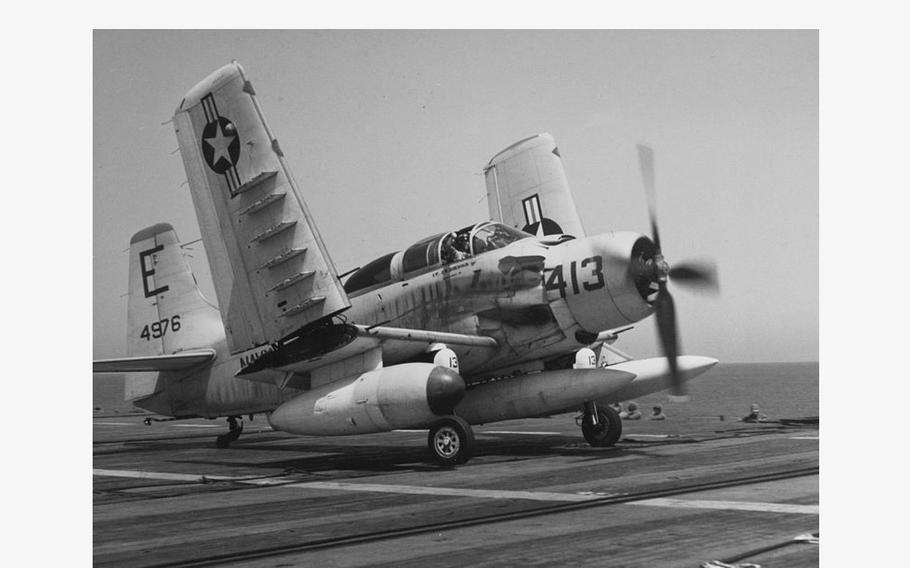
A Douglas AD-5 Skyraider attack plane is seen with its wings folded up. A Skyraider that was ditched in the Atlantic in 1957 was found by accident in deep water by divers on a routine training mission in July 2023. (U.S. Navy)
(Tribune News Service) — During a late afternoon routine training mission about a mile off Miami Beach and Key Biscayne, Marine Corps 1st Lt. Richard Lee McCombs experienced “catastrophic” oil pressure loss in the engine of his Douglas AD-5 Skyraider attack plane.
McCombs knew the plane, on a machine-gun-strafing exercise, was going down quickly. So the 25-year-old pilot headed farther out to sea to avoid the beach area.
He crash-landed into deeper water in the Atlantic Ocean.
About a half-hour later, according to news accounts at the time, a Marine rescue helicopter crew plucked him safely from the water.
The AD-5 Skyraider he ditched that January day in 1957 has remained in two pieces 66 years later — about 1,000 feet from each other — deep below the surface on the ocean floor.
The discovery
In July, Michael C. Barnette and Jimmy Gadomski, scuba divers with the Association of Underwater Explorers, found the wreckage off Miami.
A month after McCombs’ water landing in ‘57, the Marines recovered the engine, and the Coast Guard towed the rest of the aircraft farther out to sea to be sunk, Barnette said.
The divers aren’t revealing the exact location or coordinates because the plane is still Navy property, Barnette told the Miami Herald.
He said the wreckage rests “beyond the recreational diving depth limits” of 130 feet.
Barnette, 52, who has played an active role in identifying more than 20 shipwrecks worldwide and has written three books on Florida shipwreck and maritime history, said he and Gadomski weren’t looking for the Skyraider when they came upon it while diving this summer.
They were heading back to the boat ramp when they decided to first check out coordinates a fisherman gave Barnette. Having accumulated an extensive database of archival information over the years, he decided to dive some of the sites on a hunch they may turn up a shipwreck or lost aircraft.
His intuition paid off.
“This was an accidental discovery,” he said. “We were shocked and astonished to find the wreck of an unidentified military aircraft resting off Key Biscayne. It was an exciting moment.”
Using photographs that Barnette and Gadomski took of the wreckage, the Association of Underwater Explorers created a “photogrammetry model” of what the intact aircraft would look like on the ocean floor.
The story of the plane’s history and discovery will be featured on an episode of the History Channel’s series “Bermuda Triangle: Into Cursed Waters,” which premieres Nov. 14.
The pilot
After the crash, McCombs, who died at age 90 in Ohio on July 7, 2022, went on to have a distinguished career as a Marine Corps aviator. He flew the F9F Panther jet fighter and eventually, the HRS helicopter, according to his obituary.
Another news account reported that McCombs’ experience being rescued by a helicopter influenced his decision to switch from fixed-wing to rotary flying.
After the Marines, McCombs became a commercial artist and an advertising executive before opening his own printing business.
His wife of 67 years, Florence, who was a U.S. Navy nurse when they met while he was in flight training in Pensacola, died a little more than two weeks before him, according to her obituary. The couple are survived by their three adult children and grandchildren and great grandchildren.
At the time of the crash, Richard McCombs was stationed at Marine Corps Air Station Miami, which is now Miami-Opa-locka Executive Airport.
The plane
The AD-5 Skyraider, redesignated the A-1 in 1962, saw action in the Korean and Vietnam wars as an attack bomber, close-air support plane and search-and-recovery aircraft, according to the Cavanaugh Flight Museum in Addison, Texas.
It was one of the few propeller combat planes used regularly in the jet era.
©2023 Miami Herald.
Visit miamiherald.com
Distributed by Tribune Content Agency, LLC.